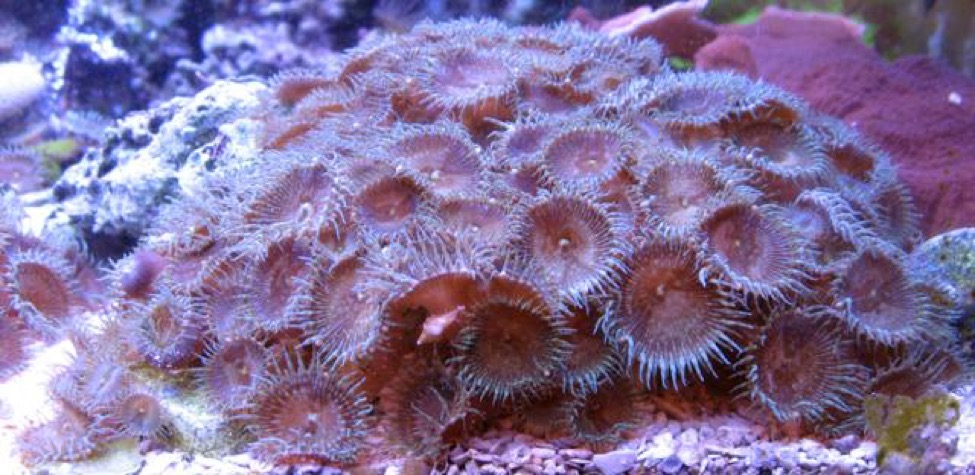
The oceans are full of creatures capable of killing us; one of the more surprising marine menaces is a group of popular aquarium corals known variably as “button polyps”, “palys” and “zoas”. Rather than biting us in half or injecting us with some venomous barb, these nefarious creatures secrete a highly lethal chemical called palytoxin. This is information which is oftentimes not related properly to new aquarists, whether purposefully or through sheer ignorance or negligence on the part of retailers. Undoubtedly, there are many in this hobby who would avoid purchasing such a dangerous organism were they to be made aware of the risks. There are also likely some reading this right now who are looking at the zoas in their tank with a leery eye and pondering what to do.
It is important to understand that palytoxin is not present in every species of “zoa”. I have heard many knowledgeable aquarists incorrectly state that all “zoanthids” contain it and are therefore dangerous, which is not accurate whatsoever. Such blanket statements show a lack of expertise in these corals and the extensive research recently published on them. One such study (Deeds et al 2011) focused on aquarium specimens and found that there is likely a single lineage of button polyps which is truly dangerous to the general aquarium community. This makes proper identification of the utmost importance, so lets jump into the esoterica of invertebrate taxonomy and attempt at last to correctly identify these deadly corals and their harmless relatives.
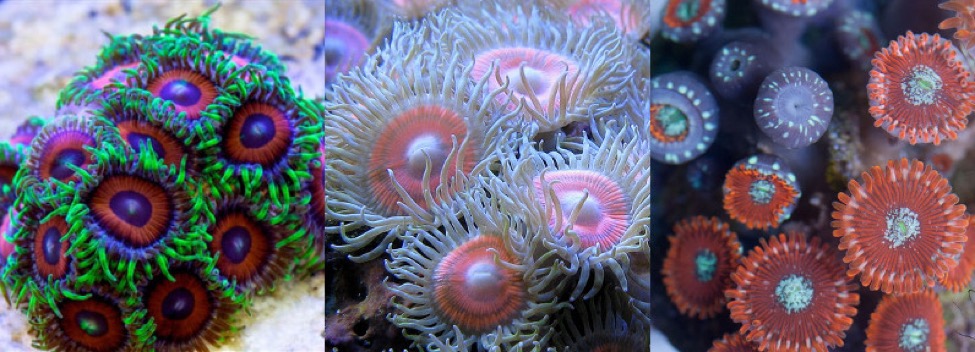
Common aquarium “zoas”: Zoanthus sansibaricus, kuroshio & gigantus. Note the white pots of the latter.
First and foremost, if your button polyps are a bright and colorful red or yellow or orange or pink, you are not in any danger. The vast majority of such specimens which enter the trade are either Zoanthus vietnamensis or Zoanthus sansibaricus. The abundant red and green zoas exported from Vietnam are the latter, and these are apparently lacking in palytoxin at any detectable level. The relatively common pink zoas are likely to be Zoanthus kuroshio, which is likewise a safe addition to your reef tank. The species most commonly referred to as “palys” in the aquarium trade are actually Zoanthus gigantus, which, if the general trend holds, can be presumed to be safe (though confirmation is needed). These are a bit larger than the previous species and come in a variety of unique and popular color patterns. The key identifying trait for them is seen in closed polyps, which have white spots and streaks apically.
The truly potent species appear to be limited entirely to the genus Palythoa, which is currently placed in a separate family, Sphenopidae. Pedantically speaking, these are neither “zoas” nor zoanthids, so be careful with your choice of words when discussing them. The outdated synonym “Protopalythoa” (formerly used for species not conjoined into a thick mat) is still in common usage throughout the aquarium industry. The best option would be for the aquarium community to come to a consensus on referring to these exclusively as “button polyps” or “palys”, but trying to get the aquarium industry as a whole to come to any consensus is similar to herding cats.

Notice the isolated lineage of P. heliodiscus (cf toxica groups here as well). From Reimer et al. 2007.
Palythoa differs most noticeably from Zoanthus by its habit of incorporating grains of sand into its tissue, giving the polyps a rougher, grainier and sturdier feel relative to the soft, limp and protean bodies of the otherwise similar “zoas”. Known specimens come mostly in shades of brown, green, and (rarely) mauve and frequently have lines radiating towards the center of the polyp. The taxonomy of the genus is currently in a state of flux, with many species having been synonymized and others likely awaiting description. This makes the difficult task of identifying the truly toxic species that much more challenging, as we may not yet understand all of the diversity present here.

Top row are the toxic specimens of Deeds et al. 2011, genetically closest to P. heliodiscus, but perhaps taxonomically distinct from it as P. cf toxica. Bottom row are further aquarium specimens likely to be of this toxic species.
The toxicity of Palythoa was first discovered when a curious researcher began looking into ancient lore concerning the “deadly seaweed of Hana”, a poison said to be lethal when applied to a spear tip. This species was described as Palythoa toxica, and it is similar to (if not the same as) the commonly seen Palythoa heliodiscus of the Indo-Pacific. This is the coral we don’t want in our aquaria, and it is, unfortunately, widely available in the aquarium trade as large colonies, as frags and as an occasional hitchhiker alongside more desirable species. It’s polyps are not deeply embedded in a thick mat (i.e. coenenchyme), without any ridges on the exterior walls of the polyp, and have relatively short tentacles (<20% of the disk diameter). Genetically, it appears to form a highly distinct lineage compared to its congeners, and, given its unique potency, there is an argument to be made that it deserves recognition as its own genus. This would certainly lend some clarity when discussing its dangers.
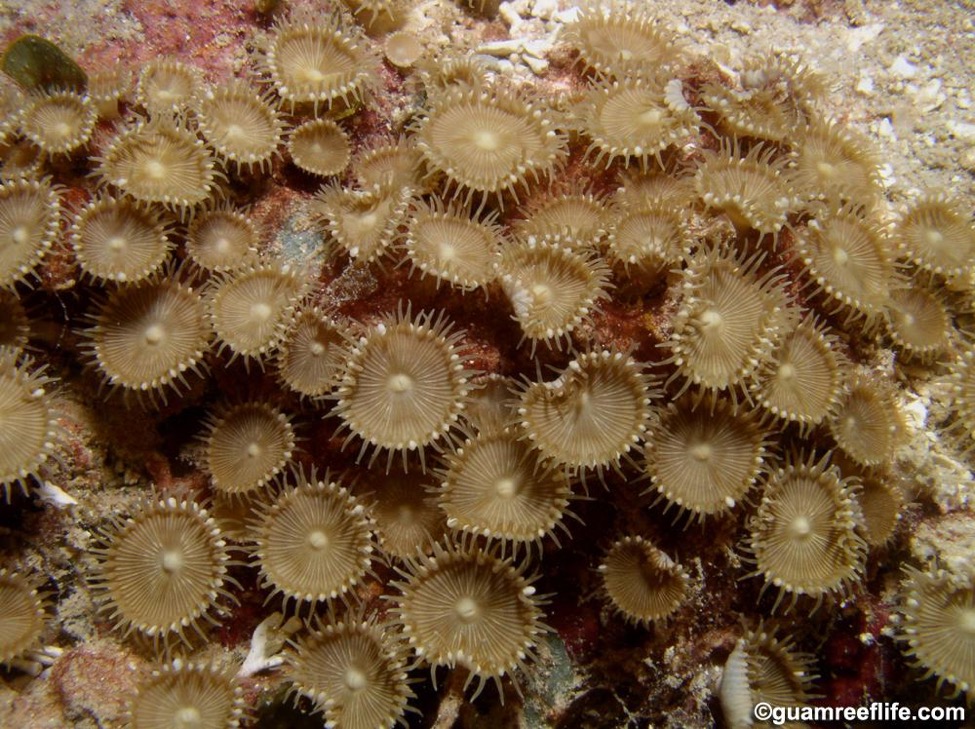
P. heliodiscus seems to always look like this. Note the tan color and thin white lines radiating from the center of the oral disc. This specimen has longer tentacles than most I’ve seen.
Whether the toxic corals of our aquariums are truly P. heliodiscus is uncertain. Specimens confirmed to be the true P. heliodiscus seem to have a highly distinctive look, consisting of a broad flat oral disc striated in tan and white, with numerous (60+) diminutive tentacles. The common aquarium species which is confirmed as highly toxic differs in having a marbled and irregular patterning (vs radiating stripes) or variable coloration and mid-length tentacles. It’s polyps appear to be a bit smaller than true heliodiscus, and perhaps more densely arranged. Genetically, the two are indistinguishable with currently used genetic markers, but this in no way signifies they are the same. More work is needed to confirm if these are the true P. toxica of Hawaii, but, alas, the native Hawaiians responsible for the type locality refuse to allow specimens to be taken for genetic study, as this location is apparently deemed to have some traditional religious significance to them. Alas!
Palythoa cf mutuki is by far the most frequently seen species for sale, but identifying it from its toxic congener can be a challenge. It is important to understand the differences, though, as cf mutuki is thought to possess little, if any, palytoxin. The most important diagnostic traits are unfortunately rather variable, and it becomes incumbent on us to learn to recognize its general gestalt. One definitive feature to look for is a series of ridges (“capitulary ridges”) near the top of closed polyps—the toxic P. heliodiscus/cf toxica appears to never possess these. The video linked below shows a great example of this. They are subtle but important!
Having said that, this feature may be more variable than indicated. Specimens lacking these ridges, but which are otherwise similar to the mutuki of Deeds et al 2011 and Ryland & Lancaster 2003, are commonly encountered. There is the (likely) possibility these are an undescribed cryptic species, as genetic data has shown there to be other specimens likely in need of description (e.g. Palythoa sp “sakurajimensis” & “singaporensis”), but whether or not this is truly P. mutuki is a bit besides the point as this phenotype has tested negative for high level of palytoxin. One feature that both the ridged and unridged mutuki phenotypes typically possess is tentacles of longer length than in the toxic heliodiscus/cf toxica. The length is often nearly equal to the radius of the oral disk, giving them a distinctively frilly look. This may allow for ready identification in all but the most short-tentacled of mutuki morphs.
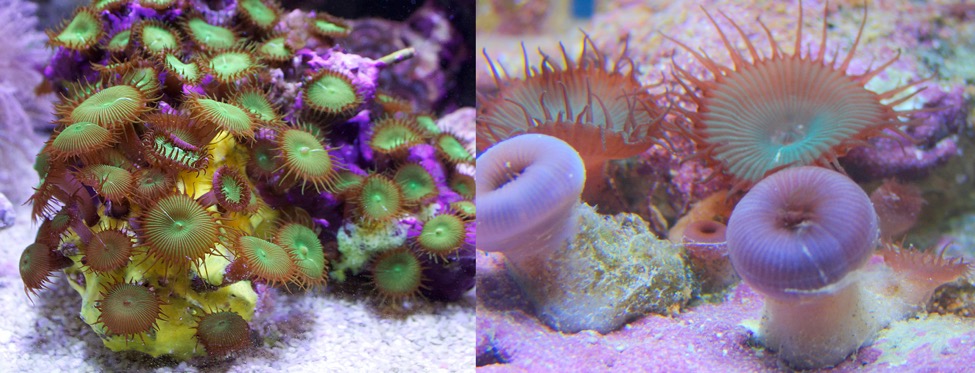
This common aquarium phenotype is P. cf mutuki. Note the long tentacles but smooth (rather than ridged) exterior.
Anecdotally, coloration alone may provide a fairly accurate method for separating mutuki and heliodiscus. The majority of green and brown button polyps seen for sale are likely to be the former, while its toxic congener tends towards a mottled combination of brown and teal. P. mutuki also tends to have a single white line (indicating the ventral directive mesentery internally), absent in heliodiscus/cf toxica. Aesthetically, the common cf toxica is a rather untidy and haggard species, and specimens have been euphemistically given the trade name of “Camo Palys”. Due in large part to its poor aesthetic appeal, heliodiscus/cf toxica is commensurately rarer in the aquarium trade.
The two also differ in their relative size, shape and bulk, with heliodiscus/cf toxica being roughly a third the volume of mutuki when large specimens of each are compared. Experienced aquarists can discern this difference, as heliodiscus/cf toxica appears to the eye as a smaller organism, even if its disc diameter is not dramatically different. Ecologically, P. mutuki is reported from intertidal to shallow subtidal habitats (often alongside Palythoa tuberculosa), and its long tentacles indicate a more predaceous existence. It also has a tendency to deeply cup its polyps, as if reaching its tentacles out to feed. Conversely, the true P. heliodiscus is known from deeper areas of the reef, often in regions of low light beneath ledges and other corals. Its meager tentacles (which lack basitrich nematocysts used for capturing prey) suggests they rely more on zooxanthellae to meet their nutritional needs. It’s not well known what habitat preferences the cf toxica phenotype has, though it is noted to be the most common subtidal Palythoa in Palau, though far rarer in Japan. The casual observation that its tentacles are often longer than the true heliodiscus, as well as aquarium observations of it readily taking foods, may indicate a more predaceous lifestyle.

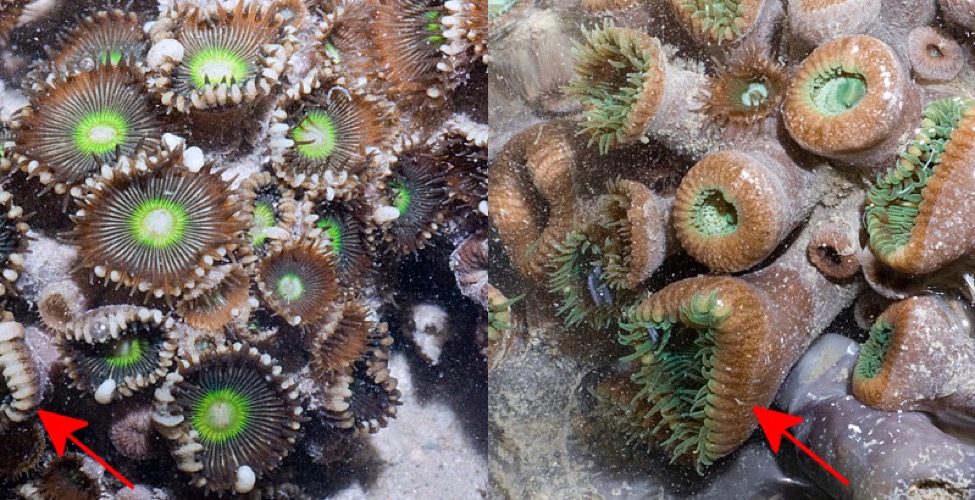








Julian Sprung this might interest you.
It’s pretty good, though some errors- Palythoa spp. can be colorful (green, purple, blue, fluorescent orange). All members of Zoanthiniaria can be called zoanthids, not just Zoanthus spp. Also, though Zoanthus spp. are generally not very toxic, they CAN contain palytoxin. The producer of palytoxin is likely a commensal bacterium, and the strength/concentration produced is controlled by unknown factors, so it is possible, in theory, for Zoanthus spp. to produce more toxin than is typically present, under special conditions.
Joe Fish ?
Julian Sprung “zoanthid” refers specifically to a member of the Zoanthidae… “zoantharian” would be the more general adjective… “zoa” is just a confusing common name, most apt for referring to Zoanthus, I guess… some colorful Palythoa are included in the second part of this article… as far as palytoxin concentration, the Deeds et al study showed minimal amounts in any of the tested corals, outside of heliodiscus/cf toxica, though the possibility remains that this could be an artifact of the small sample size… the point of my article was to emphasize which species are actually known to be dangerous, from either biochemical studies or confirmed medical cases… i’m unaware of any medical cases linked to Zoanthus, though it is of course impossible to say they are 100% safe all the time
Hi,
You can get 20 -50 free LIKES!
Visit —> { SOCLIKES . C O M- TryIT }
Here’s an interesting experience from Julian Sprung which he shared at Reefapalooza in Orlando, 2015 and graciously allowed to be filmed and shared with his Power Point presentation.
I have a 40 gallon dedicated to these beauties but I did take some effort to get them all in the same tank after hearing his story and digging deeper into the issue of Palytoxin.
https://www.youtube.com/watch?v=sgolj7laZQY